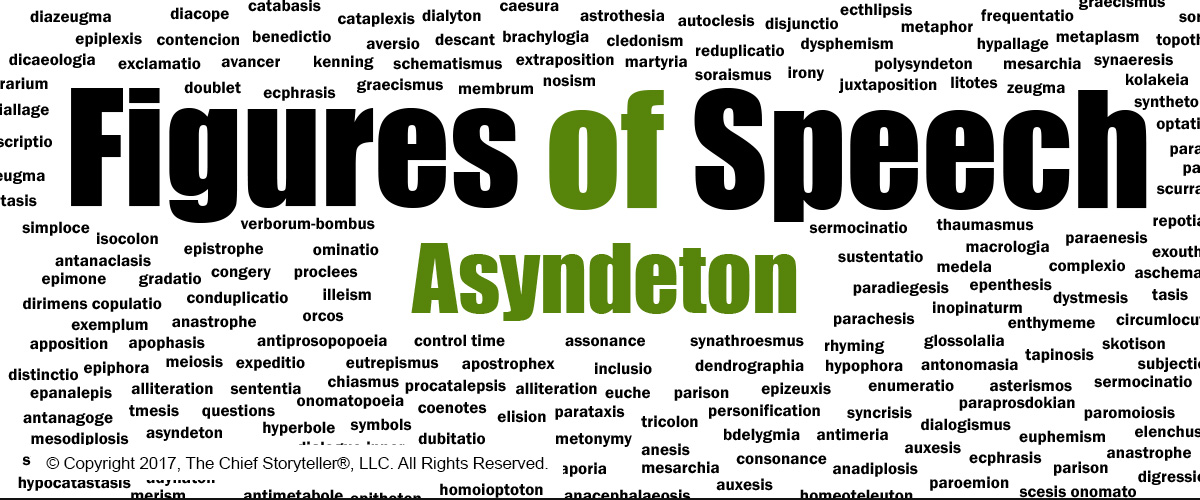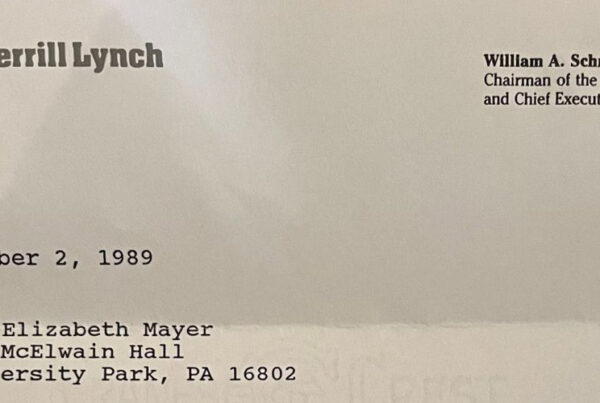
Asyndeton is a Figure of Speech for improving Emphasis & Impact. It is part of a series on figures of speech and rhetoric. I share them as the English language has hundreds of figures of speech/literary devices to help you (dramatically) improve the effectiveness and impact of your various written, spoken, and social media communication.
While I include background information, Greek word derivation, and pronunciation, what is most important is the application of each figure of speech in your communication.
I tell my consulting customers, workshop participants, coaching clients, and students (I’m an adjunct professor at The Robert H. Smith School of Business), the same thing:
“You never have to remember the actual Greek word for the figure of speech. Just remember the concept and application.”
Emphasis & Impact Figures of Speech include Anadiplosis, Anaphora, Asyndeton, Diacope, Epanalepsis, Epiphora, and Polysyndeton.
Amplification Figures of Speech include Auxesis and Epizeuxis,
Figures of Sound include Onomatopoeia.
Other Figures of Speech include Procatalepsis and Portmanteau.
There are three major sections:
- Figure of Speech. Includes a little background, usage, definition, pronunciation, other related figures of speech, and etymology.
- Usage Guidelines. Follow these guidelines to ensure maximum impact.
- Examples of Asyndeton. Find examples from speeches, presentations, presidential addresses, poems, music, and more
1) ASYNDETON – EMPHASIS AND IMPACT FIGURE OF SPEECH
Asyndeton is a dramatic literary device to make your points and stories more memorable, which leads to greater impact. Use Asyndeton for dramatic effect. Use it to quicken the pace of your speaking or the pace of the audience reading your materials. Use Asyndeton to emphasize a point as it draws attention to the cadence of the words. It draws attention because there are no conjunctions or transition words between words, phrases, clauses, or sentences.
One of the most well-known examples of Asyndeton is from Julius Caesar. He wrote “Veni, vidi, vici” in a letter to the Roman Senate after he achieved a quick victory at the Battle of Zela around 47 BC. Translated into English, the phrase becomes, “I came, I saw, I conquered.” As you read or say this out loud, you’ll immediately notice the hurried cadence or fast rhythm. This very quick and very powerful phrase is just six words long.
Because Asyndeton stands out in any communication, its effectiveness typically diminishes with repeated use. Use Asyndeton sparingly.
| Definition | Asyndeton is where there are no conjunctions or transition words between words, phrases, clauses, or sentences. Examples of conjunctions include and, for, or, so, and yet. |
| Pronunciation | ah – SIN – di – ton |
| Also Known as | Asyndetism |
| Related to | Syndeton, Polysyndeton, Parataxis, Zeugma |
| Etymology | Derived from the Greek word, ἀσύνδετον, “Unconnected” |
2) USAGE GUIDELINES
Here are some guidelines for you to ensure the use of Asyndeton achieves your communication goals:
| Use Sparingly | Too much of one type of a figure of speech or literary device will likely reduce its effectiveness and may cause your audience to miss your emphasis entirely as there are too many instances. As such use Asyndeton sparingly and for that matter, all of your figures of speech. |
| Choose a Simple Word or Phrase | If you were to analyze narratives where Asyndeton is used, you would find the authors use simple words and simple phrases. You want to ensure your audience is able to readily remember your ideas. Simple always wins the day. See Section 3 below for examples. |
| Repeat 3 Times | Since humans look for and respond to patterns, I recommend using three words, clauses, or phrases in your use of Asyndeton. This ensures your readers and listeners know with certainty you are making a point or to increase the emotional feeling of your narrative. Practice out loud and determine if two instances sounds better or perhaps four or five. |
| Use Your Orchestra |
In my training and teaching, I share specifics on how to use one’s voice to add (dramatic) impact to your spoken communication. Think of yourself as an orchestra with three main instruments: i) your Words; ii) your Body (Language); and iii) your Voice. Using your orchestra effectively, is what separates a good speaker from a great speaker. A good trainer from a great trainer. A good leader from a great leader. |
3) EXAMPLES OF ASYNDETON
Look at the examples below. See how Asyndeton is used to dramatically increase the effectiveness and impact of your words. Then experiment, mixing and combining other figures of speech in your various communication. See how pairing Anaphora with Asyndeton makes for a high impact moment.
Example 1: Howard E. Wadin & Stephen Templin, Seal Team Six: Memoirs of an Elite Navy Seal Sniper
| Without Notation | The torment continued, throughout each day. Pushups, runs, pushups. Calisthenics. Pushups… Swims… Pushups. Obstacle course… Day after day… Week after week. |
| With Notation |
The torment continued, throughout each day. { Pushups, runs, pushups. Calisthenics. Pushups… Swims… Pushups. Obstacle course… Day after day… Week after week }. |
Example 2: Robin Givhan, Washington Post, July 2018
| Without Notation | The message was clear, after all. Recoil. Agree. Shrug. She does not care. About what, precisely?
About opinions. About expectations. About anything. “I Really Don’t Care. Do U?” |
| With Notation |
The message was clear, after all. { Recoil. Agree. Shrug. She does not care. } About what, precisely?
{ About opinions. About expectations. About anything. } “I Really Don’t Care. Do U?” Note: { About opinions. About expectations. About anything. } is also an example of Anaphora. |
Example 3: Man of Many Blog, August 2016
| Without Notation | “Epic screen size. Epic display. Epic camera. Epic everything. Of course, Casey got himself the iPhone X.” |
| With Notation |
“{ Epic screen size. Epic display. Epic camera. Epic everything. } Of course, Casey got himself the iPhone X.”
Note: { Epic screen size. Epic display. Epic camera. Epic everything. } is also an example of Anaphora. |
Example 4: Tom Klein, Chief Marketing Officer, MailChimp, Marketing News of the AMA, 2018
| Without Notation | The best practice for sending is a lot of testing. Testing the message, testing the creative, testing the content, testing the timing. |
| With Notation |
The best practice for sending is a lot of testing. { Testing the message, testing the creative, testing the content, testing the timing. }
Note: { Testing the message, testing the creative, testing the content, testing the timing.} is also an example of Anaphora. |
Example 5: From One of My Student’s Final Presentation
| Without Notation | “Early one morning the head pediatrician entered my room asking, “would you be interested in speaking to a group of medical students to share your experience?” I had thought, “why not, I’m tired of laying here doing nothing, sulking in pain.” I ate, drank, laid, slept, walked. Nothing helped. Every four hours I’d hear {Beep, Beep, Beep}, alerting me that I am due for the much-anticipated dose of morphine.” |
| With Notation |
Early one morning the head pediatrician entered my room asking, “would you be interested in speaking to a group of medical students to share your experience?” I had thought, “why not, I’m tired of laying here doing nothing, sulking in pain.” I { ate, drank, laid, slept, walked. Nothing helped. } Every four hours I’d hear {Beep, Beep, Beep}, alerting me that I am due for the much-anticipated dose of morphine.
Note: { Beep, Beep, Beep } is an example of Onomatopoeia. |
Example 6: Julius Caesar’s Veni, Vidi, Vici from his Letter to the Roman Senate
| Without Notation | “Veni, vidi, vici” when translated into English, becomes becomes, “I came, I saw, I conquered.” |
| With Notation |
“Veni, vidi, vici” when translated into English, becomes becomes, “I came, I saw, I conquered.”
Note: The repetition of “I” in “I came, I saw, I conquered.” is Anaphora |
Example 7: John Scalzi’s LinkedIn Profile Professional Headline
| Without Notation | A few years ago I wrote about how interesting John Scalzi’s LinkedIn profile was. And just as interesting is his use of Asyndeton in his professional headline. It reads, “I write. I edit. I get paid. I fight crime! I lied about that last one.” |
| With Notation |
“I write. I edit. I get paid. I fight crime! I lied about that last one.”
Note: The repetition of “I” in “I write. I edit. I get paid. I fight crime! I lied about that last one.” is Anaphora |
References: I use a combination of my experience, my personal library of books and journals, sources from the Internet, and my 710-plus page Story Elements Resource Guide. My favorite sources include, in alphabetical order: American Rhetoric, Encyclopedia Britannica, LitCharts, Literary Devices, Merriam-Webster Dictionary, Oxford English Dictionary, Silva Rhetoricae, and ThoughtCo. My favorite books include: A Handbook of Rhetorical Devices by Robert A. Harris; Elements of Eloquence by Mark Forsyth; and A Handlist of Rhetorical Terms, 2nd Edition by Richard A. Lanham.
Updated July 2019
Photography Source: Message Cloud/Word Cloud designed by The Chief Storyteller®, LLC. © Copyright 2019. All Rights Reserved.
#chiefstoryteller #communication #figuresofspeech #language #rhetoric



